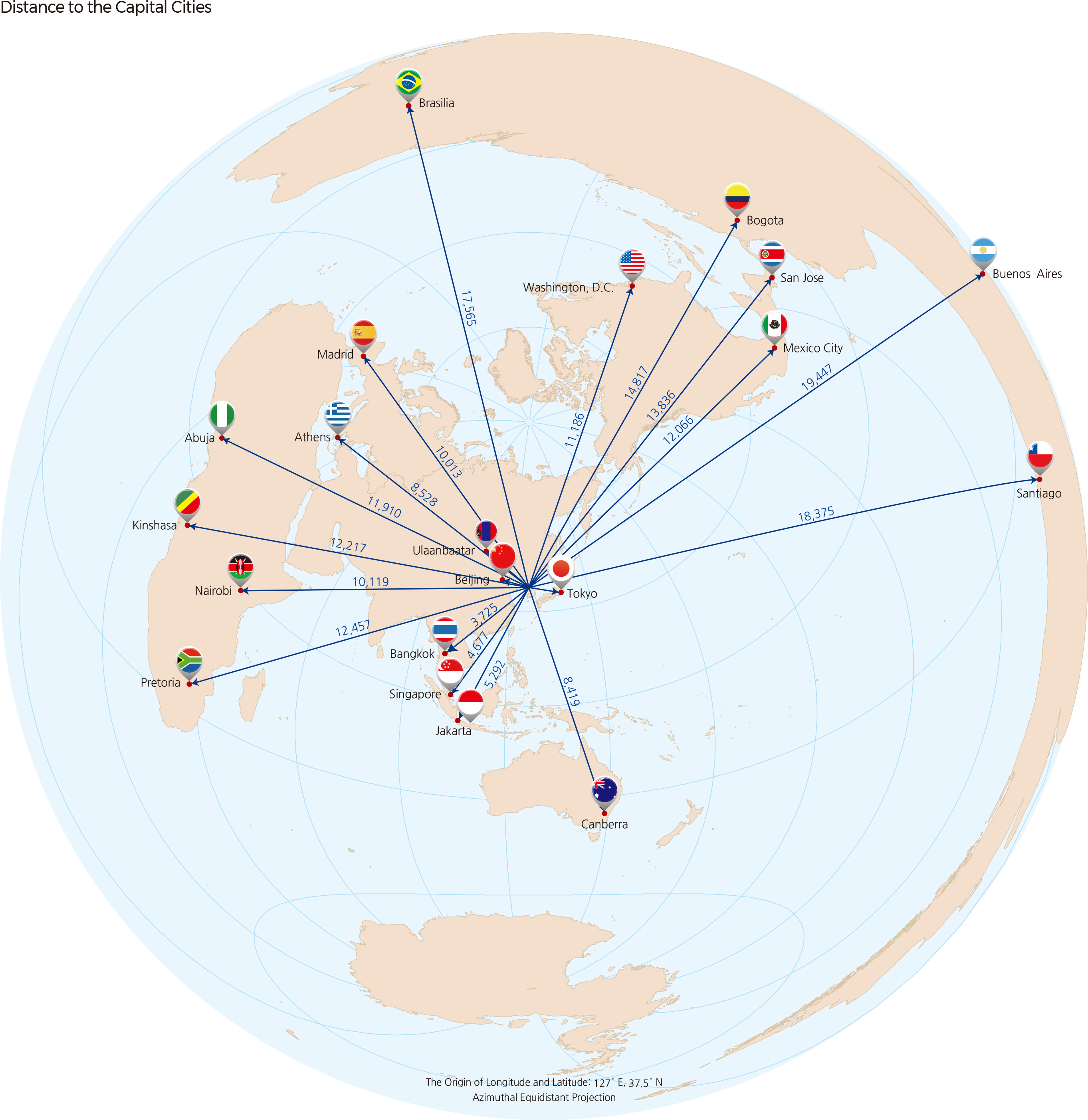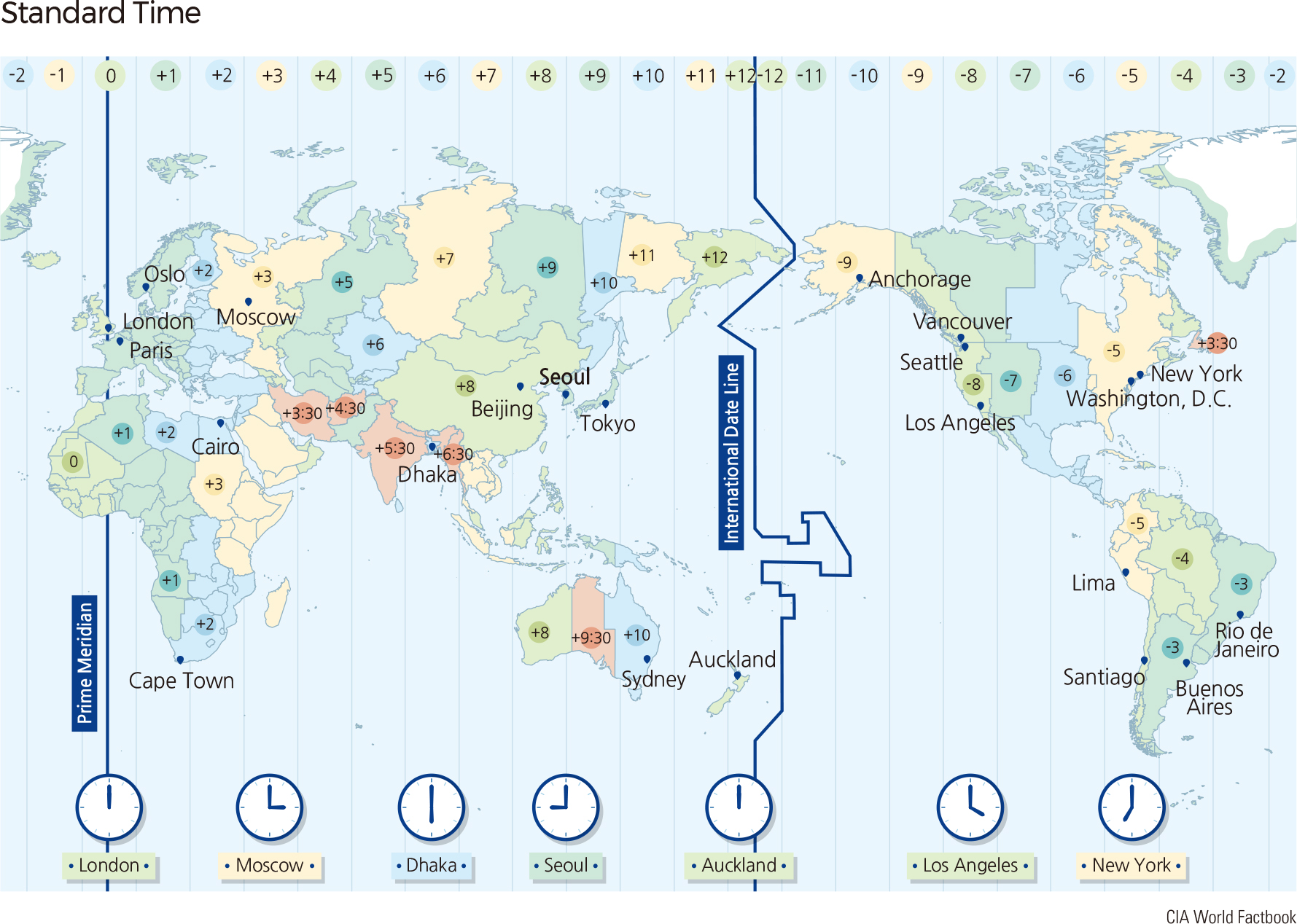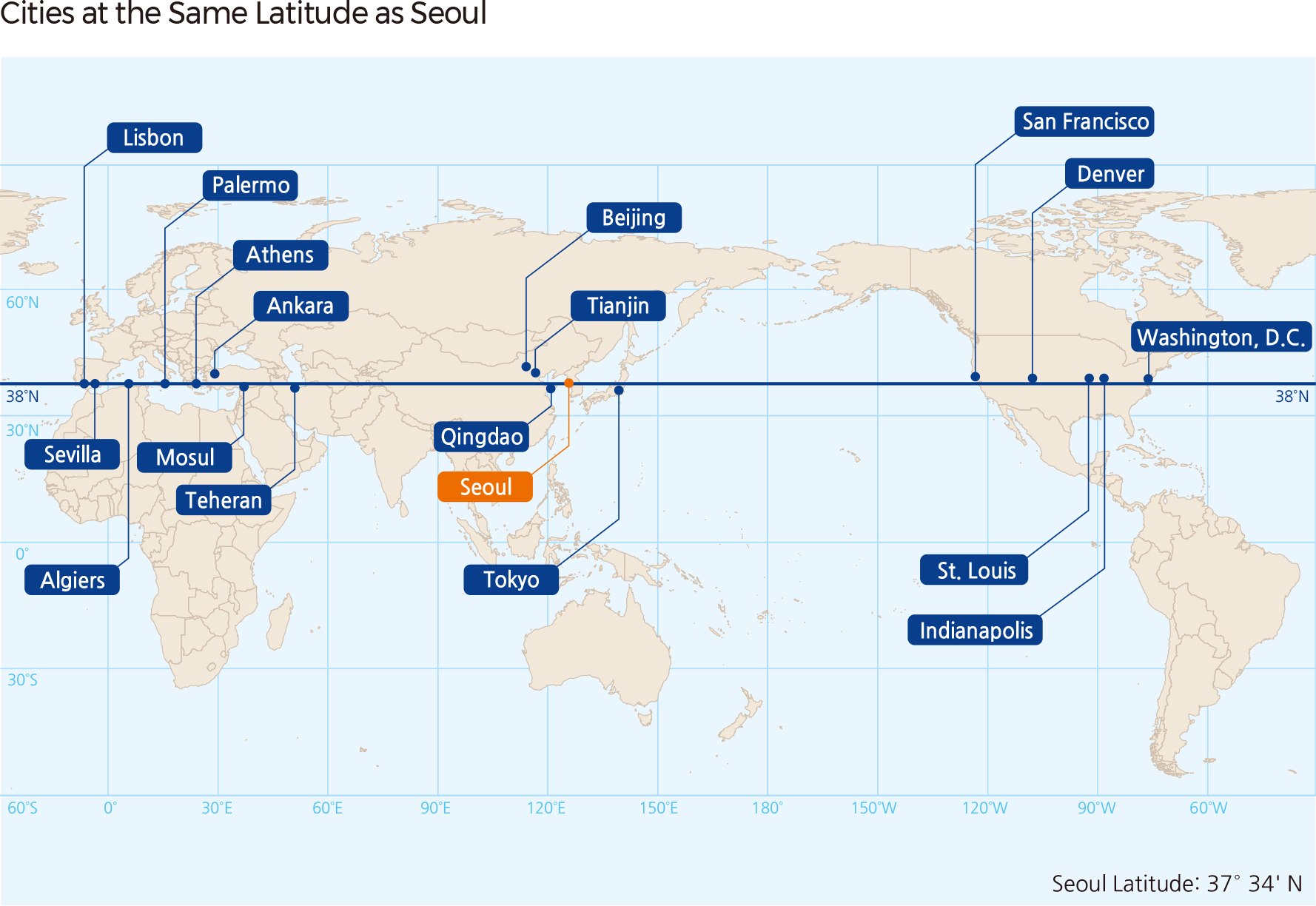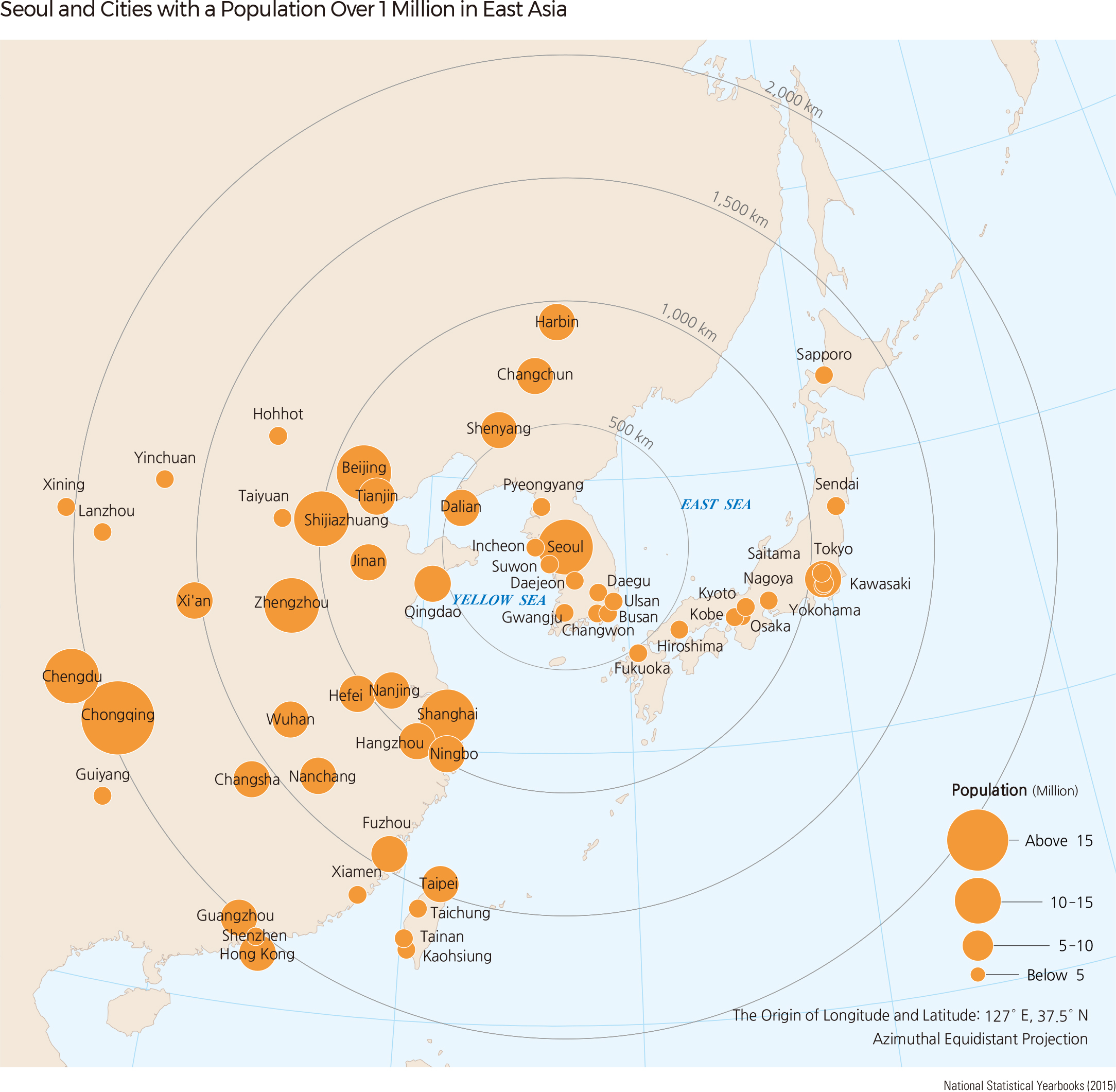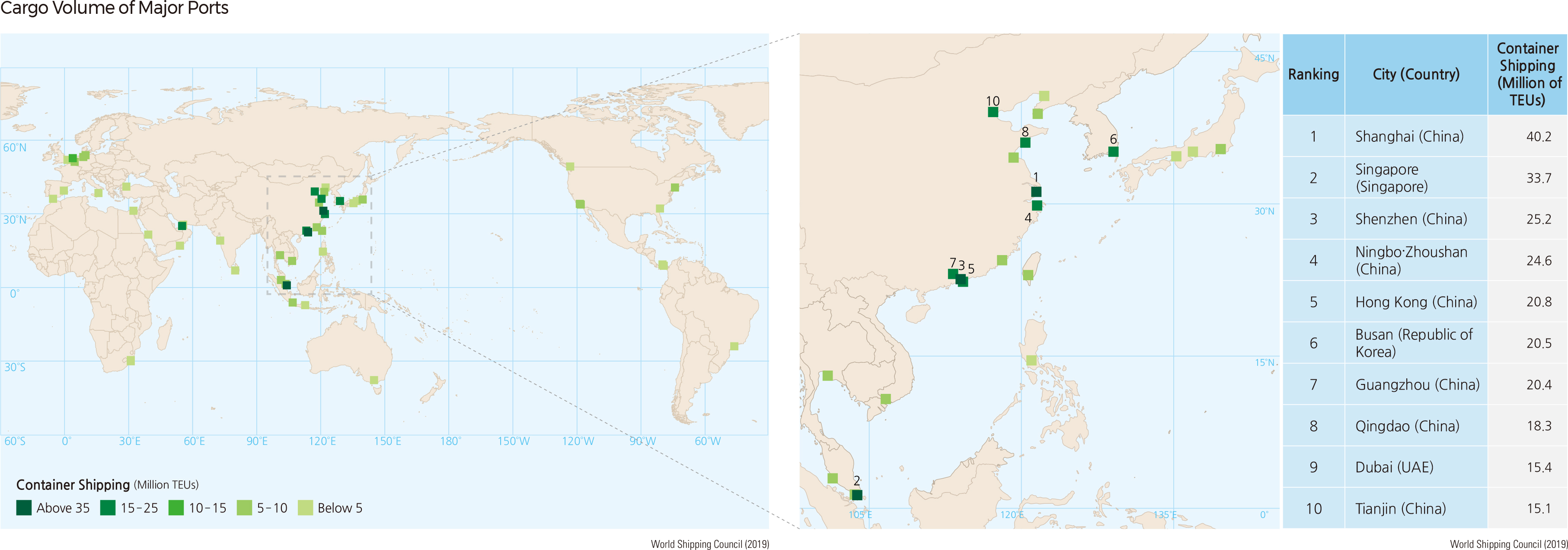English I 2019
The Korean Peninsula lies between 33 and 44 degrees north latitude and 124 and 132 degrees east longitude. Korea borders both China and Russia to the north and faces Japan across the Strait of Korea to the southeast, connecting the immense landmass of Eurasia and the Pacific Ocean.
Geographically, Korea is located in the middle of East Asia, with most major cities in the region within a radius of 5,000 km. For example, both Beijing (956 km) and Tokyo (1,157 km) are around a two-hour flight away from Seoul, and Korea enjoys high accessibility to China’s coastal cities and Japan’s large cities. Several Southeast Asian cities are within a seven-hour flight from Seoul, such as Bangkok (3,725 km) and Singapore (4,677 km), and Incheon International Airport serves as a hub for many flights from Southeast Asia to the Americas. Thanks to this closeness to Korea, Southeast Asian cities have become famous tourist destinations among Koreans. Many European cities are within 10,000 km of Korea, which makes it possible to move across Europe via major airport hubs such as Frankfurt (8,572 km), London (8,875 km), and Paris (8,981 km). The distance between Korea and the southern part of western North America is around 11,000 km, and the eastern part is approximately 12,000 km away. Direct flights are also available now to the east coast of North America. Most African cities are more than 12,000 km away from Seoul, but non-stop flights to cities on Africa’s east coast are available. The farthest continent from Korea is South America; most major cities there, such as Buenos Aires (19,447 km) and Rio de Janeiro (18,140 km), are more than 15,000 km away.
Korea uses Korean Standard Time (KST). It is appropriate to use a single standard time since the territory stretches primarily from north to south. The standard meridian of the Peninsula is 135° E, which is nine hours ahead of Coordinated Universal Time (UTC). North Korea uses KST, and neither South Korea nor North Korea uses Daylight Saving Time. Korea uses the same UTC offset (+9) as neighboring Japan and is one hour ahead of Beijing, China. The regions that share the same time zone (UTC+9) with Korea, other than Japan, are Eastern Russia, Eastern Indonesia, and East Timor, which are at a similar longitude.
The Korean Empire announced the longitude of 127° 30’ E as the standard meridian. In 1912, it was changed to 135° E by the Japanese. In 1954, it was reverted back to 127° 30’ E and that meridian has remained in use since 1961. Seoul is located at a longitude of 127 degrees, and the sun is due south at 30 minutes past noon.
Korea is located in the mid-latitudes of the northern hemisphere. Portugal, Spain, Algeria, Greece, Turkey, Iran, Iraq, China, Japan, and the United States are at similar latitudes. These countries are all in the middle latitudes and the northern temperate zone, but the amount of precipitation varies depending on the position of both the continents and nearby oceans; thus, the natural landscapes for each country are different. Cities with a latitude similar to Seoul include Washington, D.C., St. Louis, and San Francisco in the United States; Sevilla in Spain; Athens in Greece; Palermo in Italy; and Mosul in Iraq.
The geopolitical perspectives on the Korean Peninsula, located at the edge of the northeastern Asian continent, has constantly been changing. In the past, the nation’s peninsula-and-island territory was viewed as disadvantageous because it is small, dispersed, and easily exposed to outside invasion and control. However, this geographic characteristic is increasingly viewed as advantageous because the territory is open to both the continent and the ocean. This high accessibility provides economic, cultural, and geographical opportunities to the region.
The territory is located where the vast Eurasian landmass meets the extensive Pacific Ocean and is also positioned at the heart of East Asia. Therefore, it has been under the spotlight as a trade and logistical hub, and as an information and knowledge center at the core of the East Asian economy. The combined GDPs of the three major countries in East Asia (Korea, Japan, and China) are only slightly different from the GDPs of the United States and the European Union. Regional trade and economic reliance are on the rise as well. Korea has the potential to expand economically and culturally, connecting with the Eurasian landmass via North Korea and to expand its marine trade with China, Russia, and North Korea via the East and Yellow Seas. Korea is at a strategic point for developing vibrant economic and cultural exchange with other coastal and neighboring countries.
Within a 2,000 km radius of Seoul, there are around 40 cities, with more than 1 million residents, including the fast-growing east coast area of China and major Japanese cities. The Asian region centered around Seoul shows continuous economic growth along with a rapid increase in human and material movement. As of 2018, around 4.7 million Chinese, 2.94 million Japanese, and 1.11 million Taiwanese visited Korea. Likewise, 3.85 million Koreans visited China, 7.53 million visited Japan, and 1.01 million visited Taiwan.
Based on human and material resource exchange, the Asia-Pacific region accounts for 30% of the global air demand, and the percentage is expected to grow to 40% over the next two decades. Incheon International Airport ranks 5th in international passenger transportation and 3rd in international cargo transportation. In terms of marine logistics, some of the ports that handle an international cargo volume, such as Shanghai, Singapore, and Hong Kong, are located near Korea. As of 2018, Busan Port became the 6th largest marine logistics hub in container traffic. |
